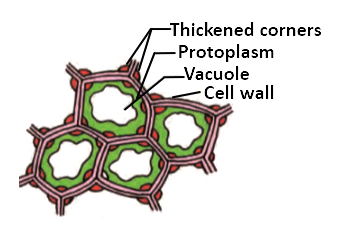Select Question Set:
In a plant, the protoxylem lies next to the phloem. This arrangement of xylem will be called:
1. Stelar
2. Extrastelar
3. Endarch
4. Exarch
Subtopic: Complex Tissue: Xylem |
63%
From NCERT
Please attempt this question first.
Hints
Please attempt this question first.
In dicot roots, initiation of lateral roots takes place in the cells of:
1. Endodermis
2. Pericycle
3. Epiblema
4. Hypodermis
1. Endodermis
2. Pericycle
3. Epiblema
4. Hypodermis
Subtopic: Anatomy of Root |
81%
From NCERT
Please attempt this question first.
Hints
Please attempt this question first.
Identify the simple tissue of plants shown in the given figure:

1. Parenchyma
2. Collenchyma
3. Sclereids
4. Sclerenchyma fibres

1. Parenchyma
2. Collenchyma
3. Sclereids
4. Sclerenchyma fibres
Subtopic: Simple Tissue: Chollenchyma & Sclerenchyma |
89%
From NCERT
Please attempt this question first.
Hints
Please attempt this question first.
For the formation of interfascicular cambium and cork cambium the parenchyma cells first undergo:
1. Differentiation
2. Dedifferentiation
3. Redifferentiation
4. Reverse differentiation
1. Differentiation
2. Dedifferentiation
3. Redifferentiation
4. Reverse differentiation
Subtopic: Activity of Cork Cambium |
75%
From NCERT
Please attempt this question first.
Hints
Please attempt this question first.
Which of the following will not be true for gymnosperms?
| 1. | Gymnosperms lack vessels in their xylem. |
| 2. | Gymnosperms have albuminous cells and sieve cells. |
| 3. | Gymnosperms lack sieve tubes and companion cells. |
| 4. | Gymnosperms lack secondary growth. |
Subtopic: Complex Tissue: Xylem | Complex Tissue: Phloem | Secondary Growth in Root (OLD NCERT) |
74%
From NCERT
Please attempt this question first.
Hints
Please attempt this question first.
Match each item in Column I with one in Column II and select the correct match from the codes given:
Codes:
| Column I [Plant part] | Column II [Vascular bundle] | ||
| A | Dicot root | P | Conjoint and open |
| B | Monocot root | Q | Conjoint and closed |
| C | Dicot stem | R | Radial, exarch, 2-6 in number |
| D | Monocot stem | S | Radial, exarch, polyarch [more than 6] |
| A | B | C | D | |
| 1. | R | S | Q | P |
| 2. | R | S | P | Q |
| 3. | P | Q | R | S |
| 4. | Q | P | S | R |
Subtopic: Anatomy of Root | Dicot Stem | Monocot Stem |
83%
From NCERT
Please attempt this question first.
Hints
Please attempt this question first.
All the following produce secondary tissues in a plant body except:
1. Fascicular vascular cambium
2. Interfascicular cambium
3. Cork-cambium
4. Intercalary meristem
1. Fascicular vascular cambium
2. Interfascicular cambium
3. Cork-cambium
4. Intercalary meristem
Subtopic: Meristematic Tissue:Classification (OLD NCERT) |
89%
From NCERT
Please attempt this question first.
Hints
Please attempt this question first.
In a monocot stem:
1. Only I and II are correct
2. Only I and III are correct
3. Only II and III are correct
4. I, II and III are correct
| I: | hypodermis is collenchymatous |
| II: | vascular bundles are conjoint and closed |
| III: | phloem parenchyma is absent |
2. Only I and III are correct
3. Only II and III are correct
4. I, II and III are correct
Subtopic: Monocot Stem |
77%
From NCERT
Please attempt this question first.
Hints
Please attempt this question first.
A transverse section of a plant part shows the following features:
| I: | Innermost layer of cortex has casparian strips. |
| II: | Pericycle has parenchymatous cells. |
| III: | Radially arranged two to four xylem and phloem patches. |
This transverse section must be of:
1. Dicot root
2. Monocot root
3. Dicot stem
4. Monocot stem
Subtopic: Anatomy of Root |
85%
From NCERT
Please attempt this question first.
Hints
Please attempt this question first.
Identify the incorrect statement regarding guard cells in the epidermal tissue system?
| 1. | They enclose stomata. |
| 2. | They are bean shaped in grasses. |
| 3. | The outer walls are thin and the inner walls are highly thickened. |
| 4. | They possess chloroplasts. |
Subtopic: Epidermal Tissue System |
83%
From NCERT
Please attempt this question first.
Hints
Please attempt this question first.
Select Question Set:






